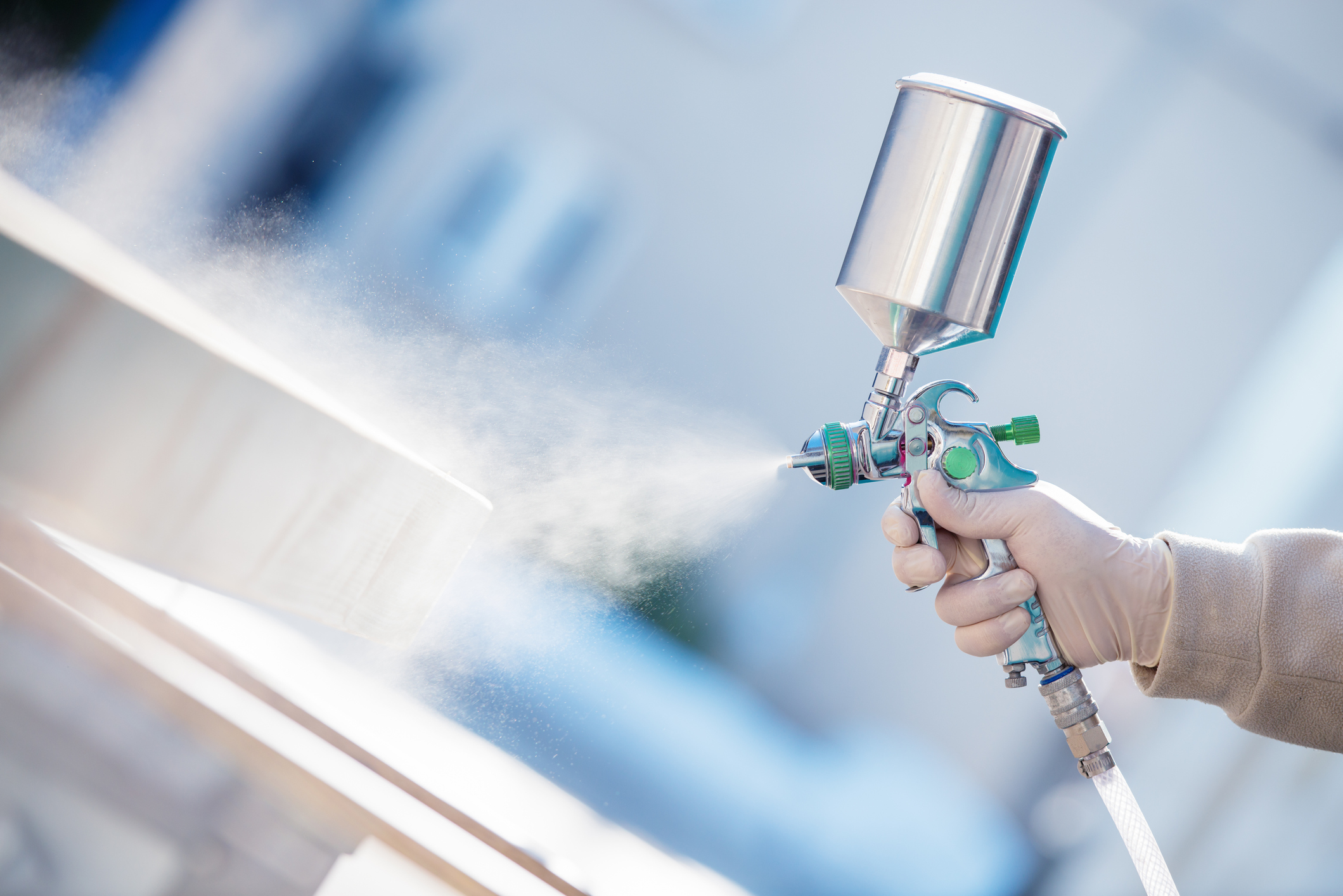How to use a paint sprayer – to achieve professional quality results
Find out how to use a paint sprayer and enjoy streak-free, high-quality results in record time


Learning how to use a paint sprayer can help you quickly and easily refresh your living spaces, and is the professional’s choice for achieving a smooth, blemish-free finish. Getting to grips with a paint sprayer requires a little practice, but it is well worth the effort, especially if you have large areas to cover.
There are several types of paint sprayers. Conventional paint sprayers, sold at your local hardware store, are aimed at DIYers and are easy to use, low fuss and affordable. You can also buy airless paint sprayers, which are best for blitzing large areas, as well as HVLP paint sprayers, which produce a finer spray and are better suited to precision jobs like stairs spindles and window frames.
The type of paint sprayer you choose to paint a room largely depends on the job in question, and the paint finishes you want to use, for example eggshell, flat or gloss paint. It’s worth talking through the options with someone at your local paint or hardware store before investing. Most experts agree that a basic paint sprayer is a great starting point for DIYers and will allow you to build up confidence before deciding whether to spring for a more serious, professional-grade kit.
How to use a paint sprayer
No matter what kind of paint sprayer you settle upon, our step-by-step guide offers expert advice to ensure perfect results every time. If you are new to paint spraying, or just looking to improve your finish, we include plenty of pro tips along the way.
You will need:
- Your chosen paint sprayer
- Your chosen paint
- Wall filler and putty knife
- Sandpaper
- Dish soap or sugar soap
- Masking tape
- Dust sheets (polythene and cotton)
- Goggles
- Dust mask
- Paint stirrer
1. Prepare your walls
One of the most important steps in painting a wall is what you do before you paint. The final painted finish can only ever be as smooth as the surface behind it, so don’t scrimp on preparing walls for painting. In truth, it can often take longer to prep the surfaces than it does to spray them!
Start by removing wallpaper and filling any cracks, holes or dings with spackle or wall filler. Allow the filler to fully dry before sanding everything down with fine grit sandpaper. Next, wipe down all the surfaces to be painted with dish soap (or sugar soap) and a sponge. This will remove any dust, as well as greasy finger marks. Finally, do a last wipe down with clean water to remove any traces of soap. Again, allow the walls to dry thoroughly.
Design expertise in your inbox – from inspiring decorating ideas and beautiful celebrity homes to practical gardening advice and shopping round-ups.
2. Mask off your painting area
‘A priority when performing any sprayed paint project is to mask all areas that you do not wish to get paint on, even if you do not think areas are at risk. This includes windows, doors, and floors, even if you are painting an area outside,’ says Annabelle Luce of ManoMano , a European home improvement retailer.
You should also mask off any walls that are going to be in a different color to the one you are working with first.
Polythene dust sheets, stuck down using masking tape, are ideal for protecting large areas from unwanted paint spray. The reusable kind are better for the environment and can last for years. Cotton dust sheets are too heavy to be taped to the walls, but they are perfect for protecting flooring from paint spray and also can be reused.
3. Don’t forget to protect yourself!
Coveralls are a must when painting using a brush or roller, but with a powered paint sprayer you’ll need extra protection. ‘When using a paint sprayer, it is strongly recommended that you wear a mask and goggles to avoid breathing in any paint spray or getting any product or fumes in your eyes. If possible, keep windows and doors open to ensure as much ventilation as possible so as to avoid breathing in any fumes,’ advises Martin Parker-Elms, category manager, B&Q.
4. Prepare your paint
Open a paint can then thoroughly mix your paint; a paint stirrer attachment that goes onto a cordless drill will make light work of this task. Some paint sprayers require paint to be diluted before application. An easy way to find out if your paint needs to be diluted is to do a quick test on a piece of cardboard. If it sprays smoothly without clogging or spitting, you’re good to go.
However, if the test spray is unsatisfactory, it will be necessary to dilute the paint. Water-based paint should be diluted with water, otherwise a thinner like white spirit will be required. Check the brush washing directions on the paint can to find out which to use.
Achieving the right dilution consistency is a gradual process that shouldn’t be rushed. Start with a ratio of 5 to 10 per cent water or thinner to paint and then do another test spray. Add a little more at a time, testing as you go, until you get the perfect spray consistency. ‘Your paint should flow smoothly and evenly through the sprayer’s hose and out the nozzle without clogging. The lower the paint viscosity, or thickness, the better to use in a sprayer. Some paint sprayers are only designed for use with specific types of paint so always check compatibility before you buy,’ says Gary McCoy, store manager at Lowe’s. ‘Paint conditioning products such as Floetrol can also be added to paint to ensure it operates well with a paint sprayer.’
5. Practice makes perfect
If you have never used a paint sprayer before it’s worth having a quick practice before you let loose on the walls. A large sheet of cardboard propped vertically is perfect. ‘Make sure the spray gun is moving before pressing the trigger and aim to apply the paint at a consistent speed as you move it across the cardboard test sheet from left to right,’ recommends Martin Parker-Elms, category manager, B&Q.
Noticeable runs in the paint indicates you’re moving too slowly so just speed up your wrist action a little. If you move too quickly or the nozzle is too far away, the results will look patchy.
6. Get painting
Always begin spraying from the top of the room down, holding the trigger approximately 8in/20cm from the wall. Use a small step ladder that is sturdy and easy to maneuver to reach the top of walls and ceilings if necessary.
‘It is best to start in a corner and spray from side-to-side, with a slight overlap on each stroke, while keeping the spray gun moving at a consistent speed,’ says Annabelle Luce, from ManoMano. ‘Once you have finished one surface, shine a light at different angles to check for any spots that need more paint.’
It’s better to build up your paint finish in thin layers than to flood the surface with paint and risk runs. Once you have covered the full area horizontally, switch to vertical and go over it again, also overlapping slightly on each stroke. If you need to do a second coat, allow the paint to dry first – check for drying times on the paint can.
Finally, remove the masking tape and admire your pristine, velvety smooth walls without a brush mark in sight.
Is it easy to clean a paint sprayer?
There’s no doubt it takes longer to thoroughly clean a paint sprayer than it ever will to clean brushes, but it’s a vital step to ensure it works perfectly next time you want to paint.
‘After switching off the machine and unplugging it from the wall, detach the removable parts, such as the nozzle, and clean them under running water or in a bucket of soapy water,’ says Martin Parker-Elms, category manager, B&Q. ‘Once the paint container has been emptied of paint and cleaned, refill it with clean water and reattach the sprayer. Switch the machine back on and spray into a bucket until the spray is no longer discolored by paint.’
Use an old toothbrush or bottle brush to dig out any last stubborn spots of paint, especially in the nozzle and ensure everything is dry before you store it away.
So you can touch up paint on walls in future, store unused paint safely and make sure to dispose of paint conscientiously when you no longer need it.
Is is quicker to paint with a paint sprayer?
Anyone tackling a complete renovation or figuring out how to paint a house exterior can expect to shave days off their decorating schedule by using a powered paint sprayer compared to using a roller or a brush, and save a lot of muscle work in the process. Most experts agree that paint sprayers are not the best tool for small, straightforward areas, though.
‘A paint sprayer is easy to use for larger projects and can deliver a quality finish covering broad surfaces faster, with less effort than using paint rollers or brushes. However, if you are executing a smaller paint project, paint sprayers are usually not the best option as you may spend more time with preparation work and with clean-up than you would with the actual painting,’ explains Gary McCoy, store manager at Lowe’s.
Linda graduated from university with a First in Journalism, Film and Broadcasting. Her career began on a trade title for the kitchen and bathroom industry, and she has worked for Homes & Gardens, and sister-brands Livingetc, Country Homes & Interiors and Ideal Home, since 2006, covering interiors topics, though kitchens and bathrooms are her specialism.
